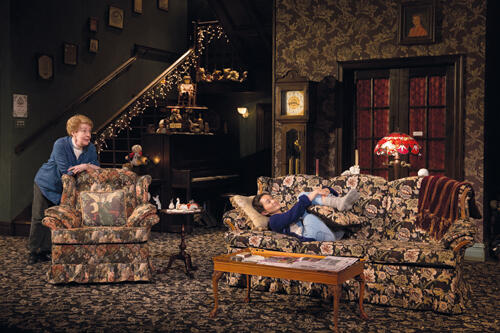Play for Time
Why theatre remains vital
Why theatre remains vital

Some New Yorkers can’t be bothered to see plays. To them, they’re old-fashioned, except maybe a piece by an avant-garde director. Theatrical conventions and traditions, unlike those of other art forms – painting, photography, sculpture – are just outmoded. Maybe the ‘happenings’ of the 1950s and then performance art, from the late 1960s into the present, destroyed interest in or supplanted ‘theatre’. There are many terrible plays; bad art is everywhere. Movies, TV, the internet, same thing; still, they’re cheap dates. Money is an issue, yet, paraphrasing Gertrude Stein, you either buy art or eat at expensive restaurants.
I’m compelled by good writing, and also like to hear actual humans speak it, standing in front of others, acting like people – verisimilitude is fiction’s truth. ‘Liveness’ agitates audiences grounded in TV, movies or cruising the web. There, a viewer can be stealthy, a domestic spy. See them, but they don’t see you. Anonymity! But when a curtain opens on a play, and actors appear, there’s an awkward moment, with a palpable sensation: Everyone’s alive! They are. You are. Plus, you’re visible. Anyone can see you, watching. It ignites a particular spark of anxiety. I prefer it to my usual brand.
Annie Baker’s new play, John (2015), uses, refuses and reconsiders theatrical conventions. John works with real- and stage-time, and doesn’t pretend not to be a play. The curtain is opened and closed by Mertis, one of its four characters. Through three acts, the set stays the same, only the actors move around, while a ticking grandfather clock on stage is also changed by Mertis. The lighting subtly shifts night into day, day into night. Sam Gold directed John, and has a great sense of time; he also directed Baker’s play The Flick (2013). Its single set is an empty movie-house, where the actors (ushers; projectionist) talk as they clean up, preparing for the next audience. A theatre audience watching The Flick confronts itself, in a way, as an absence.
In John, the question gets asked of Jenny (part of a couple with boyfriend, Elias): ‘Do you ever feel watched, Jenny?’ Being a watcher or being watched is a trope in the play, but not as Harold Pinter might have done it. Baker has a little Pinter in her lineage; she shares a suspicion of human behaviour and likes spare dialogue. Unlike Pinter’s characters, hers are not victims or victimizers. Or, her terrain has them as both and neither, and more unstable.
John: Imagine Christmas in a suffocating, charming B&B located in Gettysburg, Pennsylvania, the site of a devastating Civil War battle, where Abe Lincoln delivered his famous address, ‘Four score and seven years ago …’ Like history, the B&B is cluttered with old objects, baby dolls, a glowing Christmas tree, gnomes, porcelain angels. The dining room is called Paris, because of its faux Parisian decor. Jenny and Elias spend a few nights, while the two older women, Mertis, who owns the B&B, and is a mysterious thinker, and her friend, Genevieve, who is blind, dote on them or toss them odd life stories and insights.
Genevieve opens the second act, saying: ‘That was about the time I went crazy.’ She wears dark glasses; obviously, she can’t see, but Genevieve sees and hears what others don’t. We all – on stage, in the audience – can see her, but what is seen or not seen – not understood, possibly not ever to be understood – makes the play. Genevieve is part of the narrative, and also an extra-diegetic commentator, on plays, for one thing. At the end of Act II, after the curtain’s been closed, she comes out front to speak to the audience. ‘Don’t go yet. Stay five more minutes. I’m going to tell you a story.'
John unfolds in time, through silences, monologues, dialogues, in a series of psychological encounters of twos, threes and fours. These meetings may fuse the experiences of the characters, or not. The play slides from naturalistic to absurd, dramatic to whimsical, comic to serious. Baker’s writing has a wry inquisitiveness to it. She has a beautiful mind. Her characters go off, written into their own spheres of interest; following them, both viewers and characters get pulled into unlikely corners. A play is words, also intensely physical, with actual bodies in space, and a viewer must watch and listen hard. A play foregrounds thinking. Words cause other words to come, and actions happen. Thinking is present as an activity, and spoken and unspoken thoughts make up the play. It is the play. Still, some can’t accept looking at people on a proscenium stage, the artificiality bothers them and they can’t suspend disbelief. Is there art without artifice? I don’t know it.
























